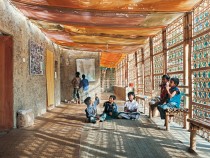
© Naquib Hossain
In Rudrapur, a town with a population of 3,000 people in northern Bangladesh, a model project is currently being developed with the aim of renewing traditional, ecological forms of construction and reviving awareness of them among inhabitants. For the most part, people have grown accustomed to using industrially produced materials rather than local products that are available without any great energy input. Native craftsmen, teachers and pupils have been supported in implementing this scheme by the foreign planning team. The long-term goal of the undertaking is to achieve a permanent improvement of living conditions in this remote region, and it is hoped that local people, who mostly work as day labourers, will learn modernized construction techniques from the area and subsequently apply them and hand them on elsewhere. An independent supply of energy is all-important: photovoltaic panels provide electricity; hot water is produced by a solar plant; and over the sanitary tract a large water tank has been installed. The underlying principle is to be found in a compact, two-storey, mud and bamboo form of construction instead of the usual single-storey brick or corrugated-metal huts.






